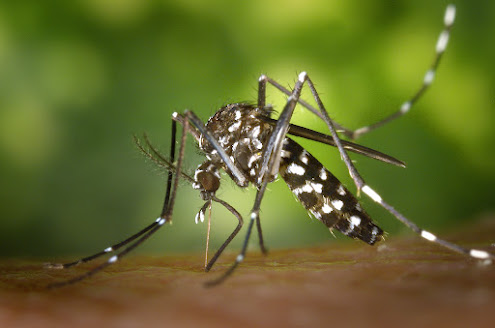 |
| Aedes aegypti mosquito. Photo Credit: Pixabay |
A new study has identified potential broad-spectrum antiviral agents that can target multiple families of RNA viruses that continue to pose a significant threat for future pandemics. The study, led by Gustavo Garcia Jr. in the UCLA Department of Molecular and Medical Pharmacology, tested a library of innate immune agonists that work by targeting pathogen recognition receptors, and found several agents that showed promise, including one that exhibited potent antiviral activity against members of RNA viral families.
The ongoing SARS-CoV-2 pandemic, which has claimed nearly seven million lives globally since it began, has revealed the vulnerabilities of human society to a large-scale outbreak from emerging pathogens. While accurately predicting what will trigger the next pandemic, the authors say recent epidemics as well as global climate change and the continuously evolving nature of the RNA genome indicate that arboviruses, viruses spread by arthropods such as mosquitoes, are prime candidates. These include such as Chikungunya virus (CHIKV), Dengue virus, West Nile virus and Zika virus. The researchers write: “Given their already-demonstrated epidemic potential, finding effective broad-spectrum treatments against these viruses is of the utmost importance as they become potential agents for pandemics.”
In their new study, published in Cell Reports Medicine, researchers found that several antivirals inhibited these arboviruses to varying degrees. “The most potent and broad-spectrum antiviral agents identified in the study were cyclic dinucleotide (CDN) STING agonists, which also hold promise in triggering an immune defense against cancer,” said senior author Vaithi Arumugaswami, Associate Professor in the UCLA Department of Molecular and Medical Pharmacology and a member of the California NanoSystems Institute.
“A robust host antiviral response induced by a single dose treatment of STING agonist cAIMP is effective in preventing and mitigating the debilitating viral arthritis caused by Chikungunya virus in a mouse model. This is a very promising treatment modality as Chikungunya virus-affected individuals suffer from viral arthritis for years and decades from the initial infection,” Arumugaswami added.
“At molecular level, CHIKV contributes to robust transcriptional (and chemical) imbalances in infected skin cells (fibroblasts) compared to West Nile Virus and ZIKA Virus, reflecting a possible difference in the viral-mediated injury (disease pathogenesis) mechanisms by viruses belonging to different families despite all being mosquito-borne viruses,” said senior author Arunachalam Ramaiah, Senior Scientist in the City of Milwaukee Health Department.
“The study of transcriptional changes in host cells reveals that cAIMP treatment rescues (reverses) cells from the harmful effect of CHIKV-induced dysregulation of cell repair, immune, and metabolic pathways,” Ramaiah added.
The study concludes that the STING agonists exhibited broad-spectrum antiviral activity against both arthropod-borne- and respiratory viruses, including treaded SARS-CoV-2 and Enterovirus D68 in cell culture models.
Garcia notes, “The next step is to develop these broad-spectrum antivirals in combination with other existing antivirals and be made readily available in the event of future respiratory and arboviral disease outbreaks.”
Funding: This study is supported by the National Institute of Health awards 1R01EY032149-01, 5R01AI163216-02 and 1R01DK132735-01 to Vaithi Arumugaswami.
Published in journal: Cell Reports Medicine
Authors: The study’s first author is Gustavo Garcia Jr., a (former) UCLA Staff Research Associate, and the co-first author is Joseph Ignatius Irudayam, a (former) UCLA Project Scientist. Corresponding authors are Vaithilingaraja Arumugaswami, a UCLA associate professor of molecular and medical pharmacology, a member of the UCLA Broad Stem Cell Research Center, and a member of the California NanoSystems Institute at UCLA, and Arunachalam Ramaiah of the City of Milwaukee Health Department. Other authors are Arjit Vijey Jeyachandran, Swati Dubey, Christina Chang, Sebastian Castillo Cario, Nate Price, Angelica L. Marquez, Aayushi Shah,Amir Fanaei, Nikhil Chakravarty, Shantanu Joshi, Samuel W. French, all of UCLA; Sathya Arumugam of Government College Daman, India; Sanjeev Sinha of All India Institute of Medical Sciences, India and Mark S. Parcells of University of Delaware.
Source/Credit: University of California, Los Angeles. Health
Reference Number: vi043023_01







.jpg)